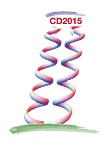Conveners
Parallel Session 2 -Few-Body Physics WG
- Akaki Rusetsky (HISKP, University of Bonn)
- Assumpta Parreno Garcia (Universitat de Barcelona)
- Dean Lee (North Carolina State University)
Matthias Schindler
(University of South Carolina, Columbia)
29/06/2015, 16:20
Few-Body Physics Working Group
Talk
Parity-violating interactions between nucleons are the manifestation of an interplay of strong and weak interactions between quarks in the nucleons. Because of the short range of the weak interactions, these parity-violating forces provide a unique probe of low-energy strong interactions. An ongoing experimental program is mapping out this weak component of the nuclear force in few-nucleon...
Michael Gericke
(University of Manitoba, Winnipeg)
29/06/2015, 16:45
Few-Body Physics Working Group
Talk
The n3He experiment aims to measure the parity violating asymmetry in the direction of proton emission in the reaction vec{n}+3He-> 3H+p, using the capture of polarized cold neutrons in an unpolarized gaseous 3He target. Using effective field theory based calculations, the size of the asymmetry is estimated to be in the range of (-9.5 --> 2.5) X 10^{-8}, and our goal measurement accuracy is 2...
Alessandro Baroni
(Old Dominion University, Norfolk)
29/06/2015, 17:00
Few-Body Physics Working Group
Talk
We present the derivation of two-nucleon axial charge and current operators in chiral effective field theory up to order Q in the power counting, where Q denotes generically the low momentum scale. The derivation is based on time-ordered perturbation theory, and accounts for cancellations between the contributions of irreducible diagrams and those due to non-static corrections from energy...
Alejandro Kievsky
(INFN-Pisa)
29/06/2015, 17:15
Few-Body Physics Working Group
Talk
Efimov physics has been intensively studied in the L=0, spatially symmetric state of the three-boson system. In the case of three nucleons, the three and four-body systems have a large symmetric component allowing the study of Efimov physics. To be recalled in this context the large values of the singlet and triplet two-nucleon scattering lengths. In this presentation we will show results for...
Tobias Frederico
(Instituto Tecnologico de Aeronautica, Sao Jose dos Campos)
29/06/2015, 17:30
Few-Body Physics Working Group
Talk
The universal properties of weakly bound tetramers close to the unitary limit are obtained by solving Faddeev-Yakubovsky (FY) equations for identical bosons with a zero-range interaction. The solution of these equations demand beside a short-range three-body scale another one for the four-boson system. We explore the correlation between trimer and tetramer energies are shown to be...
Arseniy Filin
(Ruhr University, Bochum)
29/06/2015, 17:45
Few-Body Physics Working Group
Talk
Study of pion production near threshold is interesting for several reasons: it tests applicability of chiral EFT at intermediate energies, probes nucleon-nucleon dynamics at relatively large transferred momenta, and gives possibility to study isospin violation in few-body processes. The neutral pion production in pp → ppπ0 channel has been known to be the most puzzling process for a long time....
Maxim Mai
(HISKP, University of Bonn)
29/06/2015, 18:00
Few-Body Physics Working Group
Talk
The recoil retardation effect in the K¯d scattering length is studied. Using the nonrelativistic effective field theory approach, it is demonstrated that a systematic perturbative expansion of the recoil corrections in the parameter ξ=MK/mN is possible in spite of the fact that K-d scattering at low energies is inherently nonperturbative due to the large values of the K¯N scattering lengths....

